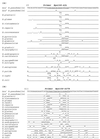Phylogenetic analysis of Ara+ and Ara- Burkholderia pseudomallei isolates and development of a multiplex PCR procedure for rapid discrimination between the two biotypes
- PMID: 10325345
- PMCID: PMC84982
- DOI: 10.1128/JCM.37.6.1906-1912.1999
Phylogenetic analysis of Ara+ and Ara- Burkholderia pseudomallei isolates and development of a multiplex PCR procedure for rapid discrimination between the two biotypes
Abstract
A Burkholderia pseudomallei-like organism has recently been identified among some soil isolates of B. pseudomallei in an area with endemic melioidosis. This organism is almost identical to B. pseudomallei in terms of morphological and biochemical profiles, except that it differs in ability to assimilate L-arabinose. These Ara+ isolates are also less virulent than the Ara- isolates in animal models. In addition, clinical isolates of B. pseudomallei available to date are almost exclusively Ara-. These features suggested that these two organisms may belong to distinctive species. In this study, the 16S rRNA-encoding genes from five clinical (four Ara- and one Ara+) and nine soil isolates (five Ara- and four Ara+) of B. pseudomallei were sequenced. The nucleotide sequences and phylogenetic analysis indicated that the 16S rRNA-encoding gene of the Ara+ biotype was similar to but distinctively different from that of the Ara- soil isolates, which were identical to the classical clinical isolates of B. pseudomallei. The nucleotide sequence differences in the 16S rRNA-encoding gene appeared to be specific for the Ara+ or Ara- biotypes. The differences were, however, not sufficient for classification into a new species within the genus Burkholderia. A simple and rapid multiplex PCR procedure was developed to discriminate between Ara- and Ara+ B. pseudomallei isolates. This new method could also be incorporated into our previously reported nested PCR system for detecting B. pseudomallei in clinical specimens.
Figures





Comment in
-
Species versus biotype status.J Clin Microbiol. 1999 Nov;37(11):3786-7. doi: 10.1128/JCM.37.11.3786-3787.1999. J Clin Microbiol. 1999. PMID: 10610379 Free PMC article. No abstract available.
References
-
- Anderson B. Broad range polymerase chain reaction for detection and identification of bacteria. J Fla Med Assoc. 1994;81:835–837. - PubMed
-
- Brett P J, DeShazer D, Woods D E. Burkholderia thailandensis sp. nov., a Burkholderia pseudomallei-like species. Int J Syst Bacteriol. 1998;48:317–320. - PubMed
-
- Brook M D, Currie B, Desmarchelier P M. Isolation and identification of Burkholderia pseudomallei from soil using selective culture techniques and the polymerase chain reaction. J Appl Microbiol. 1997;82:589–596. - PubMed
Publication types
MeSH terms
Substances
Associated data
- Actions
- Actions
- Actions
- Actions
- Actions
- Actions
- Actions
- Actions
- Actions
- Actions
- Actions
- Actions
- Actions
- Actions
LinkOut - more resources
Full Text Sources
Molecular Biology Databases

